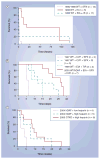Overcoming the barriers to xenotransplantation: prospects for the future
- PMID: 20402385
- PMCID: PMC2857338
- DOI: 10.1586/eci.09.81
Overcoming the barriers to xenotransplantation: prospects for the future
Abstract
Cross-species transplantation (xenotransplantation) has immense potential to solve the critical need for organs, tissues and cells for clinical transplantation. The increasing availability of genetically engineered pigs is enabling progress to be made in pig-to-nonhuman primate experimental models. Potent pharmacologic immunosuppressive regimens have largely prevented T-cell rejection and a T-cell-dependent elicited antibody response. However, coagulation dysfunction between the pig and primate is proving to be a major problem, and this can result in life-threatening consumptive coagulopathy. This complication is unlikely to be overcome until pigs expressing a human 'antithrombotic' or 'anticoagulant' gene, such as thrombomodulin, tissue factor pathway inhibitor or CD39, become available. Progress in islet xenotransplantation has been more encouraging, and diabetes has been controlled in nonhuman primates for periods in excess of 6 months, although this has usually been achieved using immunosuppressive protocols that might not be clinically applicable. Further advances are required to overcome the remaining barriers.
Keywords: antibodies; antipig; coagulation; consumptive coagulopathy; genetically engineered; nonhuman primate; pig; xenotransplantation.
Figures


Similar articles
-
Xenotransplantation of solid organs in the pig-to-primate model.Transpl Immunol. 2009 Jun;21(2):87-92. doi: 10.1016/j.trim.2008.10.005. Epub 2008 Oct 26. Transpl Immunol. 2009. PMID: 18955143 Review.
-
The immense potential of xenotransplantation in surgery.Int J Surg. 2011;9(2):122-9. doi: 10.1016/j.ijsu.2010.11.002. Epub 2010 Nov 5. Int J Surg. 2011. PMID: 21059418 Review.
-
Coagulation dysregulation as a barrier to xenotransplantation in the primate.Transpl Immunol. 2009 Jun;21(2):75-80. doi: 10.1016/j.trim.2008.10.008. Epub 2008 Nov 10. Transpl Immunol. 2009. PMID: 19000927 Free PMC article. Review.
-
Overcoming Coagulation Dysregulation in Pig Solid Organ Transplantation in Nonhuman Primates: Recent Progress.Transplantation. 2018 Jul;102(7):1050-1058. doi: 10.1097/TP.0000000000002171. Transplantation. 2018. PMID: 29538262 Free PMC article. Review.
-
Pig-to-Primate Islet Xenotransplantation: Past, Present, and Future.Cell Transplant. 2017 Jun 9;26(6):925-947. doi: 10.3727/096368917X694859. Epub 2017 Feb 3. Cell Transplant. 2017. PMID: 28155815 Free PMC article. Review.
Cited by
-
Current status of immunomodulatory and cellular therapies in preclinical and clinical islet transplantation.J Transplant. 2011;2011:637692. doi: 10.1155/2011/637692. Epub 2011 Oct 20. J Transplant. 2011. PMID: 22046502 Free PMC article.
-
The generation and evaluation of TKO/hCD55/hTM/hEPCR gene-modified pigs for clinical organ xenotransplantation.Front Immunol. 2025 Jan 20;15:1488552. doi: 10.3389/fimmu.2024.1488552. eCollection 2024. Front Immunol. 2025. PMID: 39902050 Free PMC article.
-
Prediction of individual response to anticancer therapy: historical and future perspectives.Cell Mol Life Sci. 2015 Feb;72(4):729-57. doi: 10.1007/s00018-014-1772-3. Epub 2014 Nov 12. Cell Mol Life Sci. 2015. PMID: 25387856 Free PMC article. Review.
-
Therapeutic issues in the treatment of vascularized xenotransplants using gal-knockout donors in nonhuman primates.Curr Opin Organ Transplant. 2011 Apr;16(2):222-30. doi: 10.1097/MOT.0b013e3283446c3c. Curr Opin Organ Transplant. 2011. PMID: 21415825 Free PMC article. Review.
-
Role of anti-CD40 antibody-mediated costimulation blockade on non-Gal antibody production and heterotopic cardiac xenograft survival in a GTKO.hCD46Tg pig-to-baboon model.Xenotransplantation. 2014 Jan-Feb;21(1):35-45. doi: 10.1111/xen.12066. Epub 2013 Oct 29. Xenotransplantation. 2014. PMID: 24164510 Free PMC article.
References
-
- Cooper DKC, Lanza RP. Xeno – The Promise of Transplanting Animal Organs into Humans. Oxford University Press; NY, USA: 2000.
-
- Cooper DKC, Gollackner B, Sachs DH. Will the pig solve the transplantation backlog? Annu Rev Med. 2002;53:133–147. - PubMed
-
- Cooper DKC, Ye Y, Rolf LL, Zuhdi N. The pig as potential organ donor for man. In: Cooper DKC, Kemp E, Reemtsma K, White DJG, editors. Xenotransplantation. Springer; Heidelberg, Germany: 1991. pp. 481–500.
-
-
Cooper DKC, Dorling A, Pierson RN, III, et al. α1,3-galactosyltransferase gene-knockout pigs for xenotransplantation: where do we go from here? Transplantation. 2007;84:1–7. • Useful review of the recent progress in xenotransplantation and directions for the future.
-
Publication types
MeSH terms
Substances
Grants and funding
LinkOut - more resources
Full Text Sources
Other Literature Sources
Medical
Research Materials
